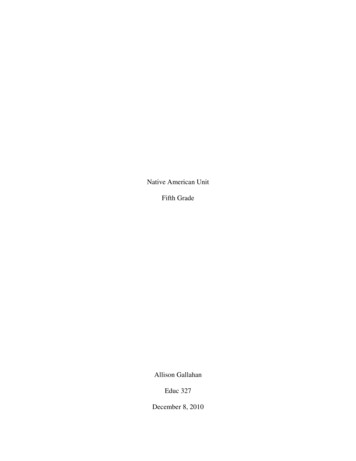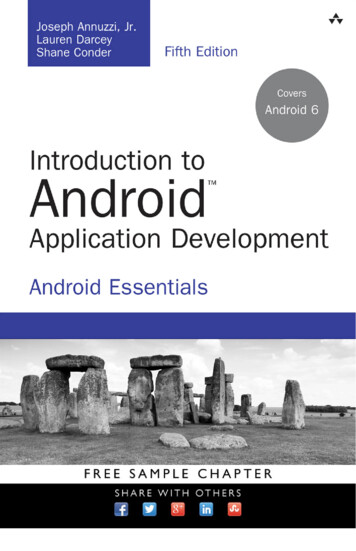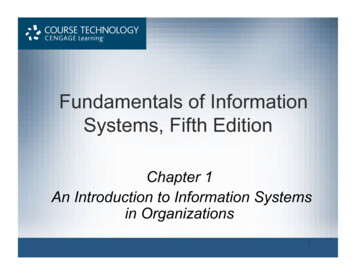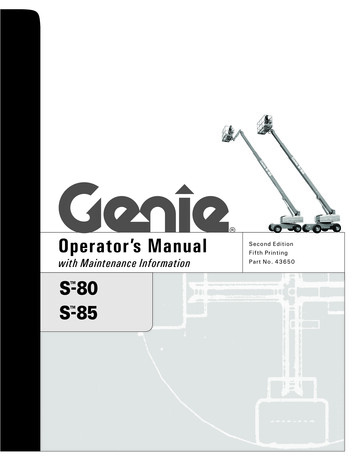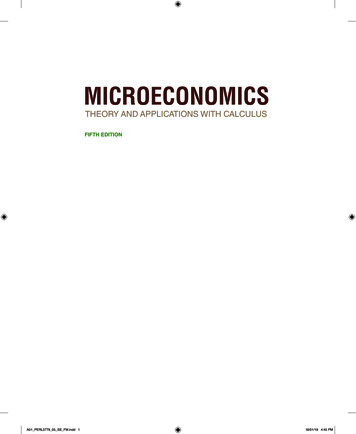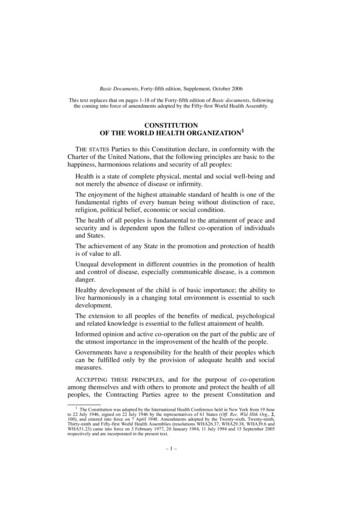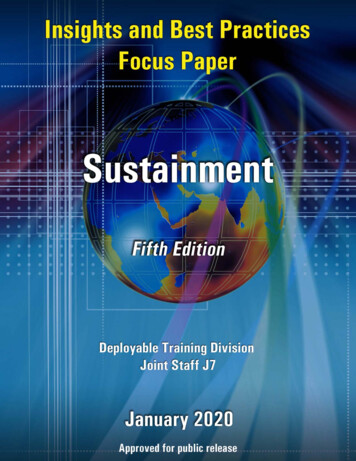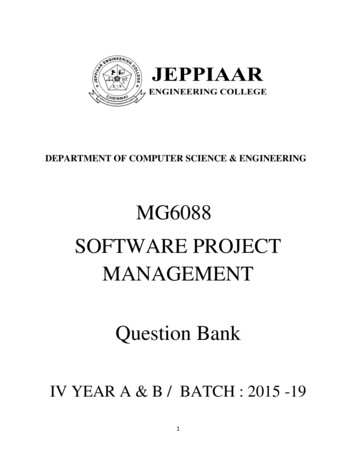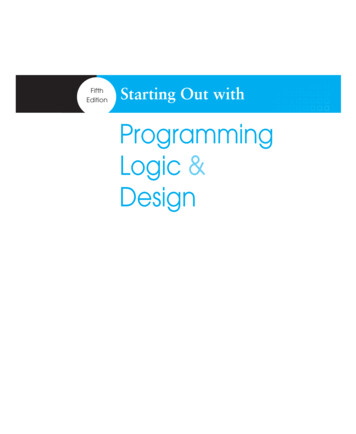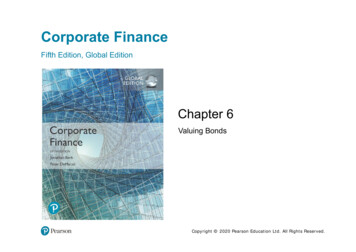
Transcription
Corporate FinanceFifth Edition, Global EditionChapter 6Valuing BondsCopyright 2020 Pearson Education Ltd. All Rights Reserved.
Chapter Outline6.1 Bond Cash Flows, Prices, and Yields6.2 Dynamic Behavior of Bond Prices6.3 The Yield Curve and Bond Arbitrage6.4 Corporate Bonds6.5 Sovereign BondsCopyright 2020 Pearson Education Ltd. All Rights Reserved.2
Learning Objectives (1 of 4) Identify the cash flows for both coupon bonds and zerocoupon bonds, and calculate the value for each type ofbond. Calculate the yield to maturity for both coupon and zerocoupon bonds, and interpret its meaning for each.Copyright 2020 Pearson Education Ltd. All Rights Reserved.3
Learning Objectives (2 of 4) Given coupon rate and yield to maturity, determinewhether a coupon bond will sell at a premium or adiscount; describe the time path the bond’s price will followas it approaches maturity, assuming prevailing interestrates remain the same over the life of the bond.Copyright 2020 Pearson Education Ltd. All Rights Reserved.4
Learning Objectives (3 of 4) Illustrate the change in bond price that will occur as aresult of changes in interest rates; differentiate betweenthe effect of such a change on long-term versus short-termbonds. Discuss the effect of coupon rate to the sensitivity of abond price to changes in interest rates. Define duration, and discuss its use by financepractitioners.Copyright 2020 Pearson Education Ltd. All Rights Reserved.5
Learning Objectives (4 of 4) Calculate the price of a coupon bond using the Law of OnePrice and a series of zero-coupon bonds. Discuss the relation between a corporate bond’s expectedreturn and the yield to maturity; define default risk andexplain how these rates incorporate default risk. Assess the creditworthiness of a corporate bond using itsbond rating; define default risk.Copyright 2020 Pearson Education Ltd. All Rights Reserved.6
6.1 Bond Cash Flows, Prices, andYields (1 of 2) Bond Terminology– Bond Certificate States the terms of the bond– Maturity Date Final repayment date– Term The time remaining until the repayment date– Coupon Promised interest paymentsCopyright 2020 Pearson Education Ltd. All Rights Reserved.7
MantelBogen8
9Coverded Bond - PfandbriefLangfristige Schuldverschreibung, die derFinanzierung von Baukrediten dient.Pfandbriefe werden von Hypothekenbanken,Schiffspfandbriefbanken und öffentlich-rechtlichenKreditinstituten ausgegeben. Sie sind ähnlich wieAnleihen ausgestattet. Durch die Beleihung vonGrundvermögen sind sie jedoch besonders gutbesichert. Ein Treuhänder kontrolliert, dass dieemittierten Pfandbriefe zu jeder Zeit in gleicherHöhe durch Hypotheken mit mindestens gleichemZinsertrag gedeckt sind.Im Sommer 1769 erließ Friedrich II eineKabinettsorder: Ein Pfandbriefinstitut, damalsLandschaft genannt, sollte den schlesischenRittergütern, die unter den Folgen desSiebenjährigen Krieges litten, günstigelangfristige Darlehen verschaffen.König Friedrich II.König von PreußenFriedrich der GroßeDer alte Fritz24. Januar 1712 - 17. August 1786Copyright 2020 Pearson Education Ltd. All Rights Reserved.
6.1 Bond Cash Flows, Prices, andYields (2 of 2) Bond Terminology– Face Value Notional amount used to compute the interestpayments– Coupon Rate Determines the amount of each coupon payment,expressed as an APR– Coupon PaymentCoupon Rate Face ValueCPN Number of Coupon Payments per YearCopyright 2020 Pearson Education Ltd. All Rights Reserved.10
Zero-Coupon Bonds (1 of 7) Zero-Coupon Bond– Does not make coupon payments– Always sells at a discount (a price lower than facevalue), so they are also called pure discount bonds– Treasury Bills are U.S. government zero-couponbonds with a maturity of up to one year.Copyright 2020 Pearson Education Ltd. All Rights Reserved.11
Zero-Coupon Bonds (2 of 7) Suppose that a one-year, risk-free, zero-coupon bond witha 100,000 face value has an initial price of 96,618.36.The cash flows would be– Although the bond pays no “interest,” yourcompensation is the difference between the initial priceand the face value.Copyright 2020 Pearson Education Ltd. All Rights Reserved.12
Zero-Coupon Bonds (3 of 7) Yield to Maturity– The discount rate that sets the present value of thepromised bond payments equal to the current marketprice of the bond Price of a Zero-Coupon bondFVP (1 YTM n ) nCopyright 2020 Pearson Education Ltd. All Rights Reserved.13
Zero-Coupon Bonds (4 of 7) Yield to Maturity– For the one-year zero coupon bond:100, 00096, 618.36 (1 YTM 1)100, 0001 YTM 1 1.03596, 618.36 Thus, the YTM is 3.5%Copyright 2020 Pearson Education Ltd. All Rights Reserved.14
Zero-Coupon Bonds (5 of 7) Yield to Maturity– Yield to Maturity of an n-Year Zero-Coupon Bond FV YTM n P 1n 1Copyright 2020 Pearson Education Ltd. All Rights Reserved.15
Textbook Example 6.1 (1 of 2)Yields for Different MaturitiesProblemSuppose the following zero-coupon bonds are trading at theprices shown below per 100 face value. Determine thecorresponding spot interest rates that determine the zerocoupon yield curve.Maturity1 Year2 Years3 Years4 YearsPrice 96.62 92.45 87.63 83.06Copyright 2020 Pearson Education Ltd. All Rights Reserved.16
Textbook Example 6.1 (2 of 2)SolutionUsing Eq . 6.3, we haveuationr1 YTM 1 100 1 3.50%96.6212 100 r2 YTM 2 1 4.00% 92.45 13 100 r3 YTM 3 1 4.50% 87.63 14 100 r4 YTM 4 1 4.75% 83.06 Copyright 2020 Pearson Education Ltd. All Rights Reserved.17
Zero-Coupon Bonds (6 of 7) Risk-Free Interest Rates– A default-free zero-coupon bond that matures on daten provides a risk-free return over the same period.– Thus, the Law of One Price guarantees that the riskfree interest rate equals the yield to maturity on such abond.– Risk-Free Interest Rate with Maturity n.rn YTM nCopyright 2020 Pearson Education Ltd. All Rights Reserved.18
Zero-Coupon Bonds (7 of 7) Risk-Free Interest Rates– Spot Interest Rate Another term for a default-free, zero-coupon yield– Zero-Coupon Yield Curve A plot of the yield of risk-free zero-coupon bonds asa function of the bond’s maturity dateCopyright 2020 Pearson Education Ltd. All Rights Reserved.19
Coupon Bonds (1 of 2) Coupon Bonds– Pay face value at maturity– Pay regular coupon interest payments Treasury Notes– U.S. Treasury coupon security with original maturitiesof 1–10 years Treasury Bonds– U.S. Treasury coupon security with original maturitiesover 10 yearsCopyright 2020 Pearson Education Ltd. All Rights Reserved.20
Textbook Example 6.2 (1 of 2)The Cash Flows of a Coupon BondProblemThe U.S. Treasury has just issued a five-year, 1000 bondwith a 5% coupon rate and semiannual coupons. What cashflows will you receive if you hold this bond until maturity?Copyright 2020 Pearson Education Ltd. All Rights Reserved.21
Textbook Example 6.2 (2 of 2)SolutionThe face value of this bond is 1000. Because this bondpays coupons semiannually, from Eq. 6.1, you will receive a5%coupon payment every six months of CPN 1000 2 25.Here is the timeline, based on a six-month period:Note that the last payment occurs five years (10 six-monthperiods) from now and is composed of both a couponpayment of 25 and the face value payment of 1000.Copyright 2020 Pearson Education Ltd. All Rights Reserved.22
Coupon Bonds (2 of 2) Yield to Maturity– The YTM is the single discount rate that equates thepresent value of the bond’s remaining cash flows to itscurrent price– Yield to Maturity of a Coupon Bond1 1P CPN 1 y (1 y ) N FV N(1 y) Copyright 2020 Pearson Education Ltd. All Rights Reserved.23
Textbook Example 6.3 (1 of 3)Computing the Yield to Maturity of a Coupon BondProblemConsider the five-year, 1000 bond with a 5% coupon rateand semiannual coupons described in Example 6.2. If thisbond is currently trading for a price of 957.35, what is thebond’s yield to maturity?Copyright 2020 Pearson Education Ltd. All Rights Reserved.24
Textbook Example 6.3 (2 of 3)SolutionBecause the bond has 10 remaining coupon payments, wecompute its yield y by solving: 1 11000957.35 25 1 10 y (1 y ) (1 y )10We can solve it by trial-and-error or by using the annuityspreadsheet:Copyright 2020 Pearson Education Ltd. All Rights Reserved.25
Textbook Example 6.3 (3 of 3)BlankGivenSolve for RateN PE RRATEPVPM TFVExcel Formula10blank 957.35251,000blankblank3.00%blankblankblank RATE (10, 25, 957.35, 1000)Therefore, y 3%. Because the bond pays couponssemiannually, this yield is for a six-month period. We convertit to an APR by multiplying by the number of couponpayments per year. Thus the bond has a yield to maturityequal to a 6% APR with semiannual compounding.Copyright 2020 Pearson Education Ltd. All Rights Reserved.26
Textbook Example 6.4 (1 of 2)Computing a Bond Price from Its Yield to MaturityProblemConsider again the five-year, 1000 bond with a 5% couponrate and semiannual coupons presented in Example 6.3.Suppose you are told that its yield to maturity has increasedto 6.30% (expressed as an A P R with semiannualcompounding). What price is the bond trading for now?Copyright 2020 Pearson Education Ltd. All Rights Reserved.27
Textbook Example 6.4 (2 of 2)SolutionGiven the yield, we can compute the price using Eq.65. First,note that a 6.30% APR is equivalent to a semiannual rate of3.15%. Therefore, the bond price isP 25 1 11000 1 944.98 10 100.0315 1.0315 1.0315We can also use the annuity spreadsheet:BlankGivenSolve for PVN PE RRATEPVPM TFVExcel Formula103.15%blank251,000blankblankblank 944.98blankblank PV (0.0315, 10, 25,1000)Copyright 2020 Pearson Education Ltd. All Rights Reserved.
6.2 Dynamic Behavior of Bond Prices Discount– A bond is selling at a discount if the price is less thanthe face value Par– A bond is selling at par if the price is equal to the facevalue Premium– A bond is selling at a premium if the price is greaterthan the face valueCopyright 2020 Pearson Education Ltd. All Rights Reserved.29
Discounts and Premiums (1 of 3) If a coupon bond trades at a discount, an investor will earna return both from receiving the coupons and fromreceiving a face value that exceeds the price paid for thebond.– If a bond trades at a discount, its yield to maturity willexceed its coupon rate.Copyright 2020 Pearson Education Ltd. All Rights Reserved.30
Discounts and Premiums (2 of 3) If a coupon bond trades at a premium, it will earn a returnfrom receiving the coupons, but this return will bediminished by receiving a face value less than the pricepaid for the bond. Most coupon bonds have a coupon rate so that the bondswill initially trade at, or very close to, par.Copyright 2020 Pearson Education Ltd. All Rights Reserved.31
Discounts and Premiums (3 of 3)Table 6.1 Bond Prices Immediately After a Coupon PaymentWhen the bond price isWe say the bond tradesThis occurs whengreater than the face value“above par” or “at apremium”Coupon Rate Yield toMaturityequal to the face value“at par”Coupon Rate Yield toMaturityless than the face value“below par” or “at a discount”Coupon Rate Yield toMaturityCopyright 2020 Pearson Education Ltd. All Rights Reserved.32
Textbook Example 6.5 (1 of 2)Determining the Discount or Premium of a Coupon BondProblemConsider three 30-year bonds with annual couponpayments. One bond has a 10% coupon rate, one has a 5%coupon rate, and one has a 3% coupon rate. If the yield tomaturity of each bond is 5%, what is the price of each bondper 100 face value? Which bond trades at a premium,which trades at a discount, and which trades at par?Copyright 2020 Pearson Education Ltd. All Rights Reserved.33
Textbook Example 6.5 (2 of 2)SolutionWe can compute the price of each bond using Eq.6.5.Therefore, the bond prices are1 1 100 176.86 1 30 300.05 1.05 1.05(trades at a premium)P(5% coupon) 5 1 1 1001 100.00 0.05 1.0530 1.0530(trades at par)P(3% coupon) 3 1 1 1001 69.26 0.05 1.0530 1.0530(trades at a discount)P (10% coupon) 10 Copyright 2020 Pearson Education Ltd. All Rights Reserved.34
Time and Bond Prices Holding all other things constant, a bond’s yield to maturitywill not change over time. Holding all other things constant, the price of discount orpremium bond will move toward par value over time. If a bond’s yield to maturity has not changed, then the IRRof an investment in the bond equals its yield to maturityeven if you sell the bond early.Copyright 2020 Pearson Education Ltd. All Rights Reserved.35
Textbook Example 6.6 (1 of 4)The Effect of Time on the Price of a Coupon BondProblemConsider a 30-year bond with a 10% coupon rate (annualpayments) and a 100 face value. What is the initial price ofthis bond if it has a 5% yield to maturity? If the yield tomaturity is unchanged, what will the price be immediatelybefore and after the first coupon is paid?Copyright 2020 Pearson Education Ltd. All Rights Reserved.36
Textbook Example 6.6 (2 of 4)SolutionWe computed the price of this bond with 30 years to maturityin Example 6.5:1 1 100P 10 1 176.86 30 300.05 1.05 1.05Now consider the cash flows of this bond in one year,immediately before the first coupon is paid. The bond nowhas 29 years until it matures, and the timeline is as follows:Copyright 2020 Pearson Education Ltd. All Rights Reserved.37
Textbook Example 6.6 (3 of 4)Again, we compute the price by discounting the cash flows by theyield to maturity. Note that there is a cash flow of 10 at date zero,the coupon that is about to be paid. In this case, we can treat thefirst coupon separately and value the remaining cash flows as inEq. 6.5:P(just before first coupon) 10 10 1 1 1001 185.71 29 290.05 1.05 1.05Note that the bond price is higher than it was initially. It will makethe same total number of coupon payments, but an investor doesnot need to wait as long to receive the first one. We could alsocompute the price by noting that because the yield to maturityremains at 5% for the bond, investors in the bond should earn areturn of 5% over the year: 176.86 1.05 185.71.Copyright 2020 Pearson Education Ltd. All Rights Reserved.38
Textbook Example 6.6 (4 of 4)What happens to the price of the bond just after the first coupon is paid?The timeline is the same as that given earlier, except the new owner ofthe bond will not receive the coupon at date zero. Thus, just after thecoupon is paid, the price of the bond (given the same yield to maturity)will beP (just after first coupon) 10 1 1 1001 175.71 29 290.05 1.05 1.05The price of the bond will drop by the amount of the coupon ( 10)immediately after the coupon is paid, reflecting the fact that the ownerwill no longer receive the coupon. In this case, the price is lower than theinitial price of the bond. Because there are fewer coupon paymentsremaining, the premium investors will pay for the bond declines. Still, aninvestor who buys the bond initially, receives the first coupon, and thensells it earns a 5% return if the bond’s yield does not change:(10 175.71) 1.05.176.86Copyright 2020 Pearson Education Ltd. All Rights Reserved.39
Figure 6.1 The Effect of Time on BondPricesCopyright 2020 Pearson Education Ltd. All Rights Reserved.40
Accrued Interest (Stückzinsen)Accrued InterestTime (Coupon Periods)Clean Price Dirty Price - Accrued Interest days since last coupon payment Accrued Int. Coupon Amount days in current coupon period Tage seit letzer Kuponzahlung Stückzinsen Kuponbetrag Tage in aktueller Kuponperiode Copyright 2020 Pearson Education Ltd. All Rights Reserved.41
Interest Rate Changes and Bond Prices(1 of 2) There is an inverse relationship between interest rates andbond prices.– As interest rates and bond yields rise, bond prices fall.– As interest rates and bond yields fall, bond prices rise.Copyright 2020 Pearson Education Ltd. All Rights Reserved.42
Interest Rate Changes and Bond Prices(2 of 2) The sensitivity of a bond’s price to changes in interestrates is measured by the bond’s duration.– Bonds with high durations are highly sensitive tointerest rate changes.– Bonds with low durations are less sensitive to interestrate changes.Copyright 2020 Pearson Education Ltd. All Rights Reserved.43
Textbook Example 6.7 (1 of 3)The Interest Rate Sensitivity of BondsProblemConsider a 15-year zero-coupon bond and a 30-year couponbond with 10% annual coupons. By what percentage will theprice of each bond change if its yield to maturity increasesfrom 5% to 6%?Copyright 2020 Pearson Education Ltd. All Rights Reserved.44
Textbook Example 6.7 (2 of 3)SolutionFirst, we compute the price of each bond for each yield tomaturity:Yield to Maturity15-Year, Zero-CouponBond30-Year, 10% Annual CouponBond5%100 48.10151.0510 1 1 1001 176.86 0.05 1.0530 1.05306%100 41.73151.0610 1 1 1001 155.06 0.06 1.0630 1.0630Copyright 2020 Pearson Education Ltd. All Rights Reserved.45
Textbook Example 6.7 (3 of 3)The price of the 15-year zero-coupon bond changes by(41.73 48.10) 13.2% if its yield to maturity increases from48.105% to 6%. For the 30-year bond with 10% annual coupons,the price change is (155.06 176.86) 12.3%.176.86Even though the 30-year bond has a longer maturity,because of its high coupon rate, its sensitivity to a change inyield is actually less than that of the 15-year zero couponbond.Copyright 2020 Pearson Education Ltd. All Rights Reserved.46
Figure 6.2 Yield to Maturity and BondPrice Fluctuations over TimeCopyright 2020 Pearson Education Ltd. All Rights Reserved.47
6.3 The Yield Curve and Bond Arbitrage Using the Law of One Price and the yields of default-freezero-coupon bonds, one can determine the price and yieldof any other default-free bond. The yield curve provides sufficient information to evaluateall such bonds.Copyright 2020 Pearson Education Ltd. All Rights Reserved.48
Replicating a Coupon Bond (1 of 3) Replicating a three-year 1000 bond that pays 10% annualcoupon using three zero-coupon bonds:Copyright 2020 Pearson Education Ltd. All Rights Reserved.49
Replicating a Coupon Bond (2 of 3)Table 6.2 Yields and Prices (per 100 Face Value) for ZeroCoupon BondsMaturity1 year2years3 years4 yearsYT M3.50%4.00%4.50%4.75%Price 96.62 92.45 87.63 83.06%Copyright 2020 Pearson Education Ltd. All Rights Reserved.50
Replicating a Coupon Bond (3 of 3) By the Law of One Price, the three-year coupon bond musttrade for a price of 1153.Copyright 2020 Pearson Education Ltd. All Rights Reserved.51
Valuing a Coupon Bond Using ZeroCoupon Yields The price of a coupon bond must equal the present valueof its coupon payments and face value.– Price of a Coupon BondV PV (Bond Cash Flows)CPNCPNCPN FV 21 YTM 1 (1 YTM 2 )(1 YTM n ) n100100 100 1000P 1153231.035 1.041.045Copyright 2020 Pearson Education Ltd. All Rights Reserved.52
Coupon Bond Yields Given the yields for zero-coupon bonds, we can price acoupon bond100100100 1000P 1153 2(1 y ) (1 y )(1 y )3100100100 1000P 1153231.0444 1.04441.0444BlankGivenSolve for RateN P E R RAT E3blankblankPVPM TFVExcel Formula 1,1531001,000blankblankblank RATE(3, 100, 1153, 1000)4.44% blankCopyright 2020 Pearson Education Ltd. All Rights Reserved.53
Textbook Example 6.8 (1 of 3)Yields on Bonds with the Same MaturityProblemGiven the following zero-coupon yields, compare the yield tomaturity for a three-year, zero-coupon bond; a three-yearcoupon bond with 4% annual coupons; and a three-yearcoupon bond with 10% annual coupons. All of these bondsare default free.Maturity1 year2 years3 years4 yearsZero- coupon Y T M3.50%4.00%4.50%4.75%Copyright 2020 Pearson Education Ltd. All Rights Reserved.54
Textbook Example 6.8 (2 of 3)SolutionFrom the information provided, the yield to maturity of the threeyear, zero-coupon bond is 4.50%. Also, because the yields matchthose in Table 6.2, we already calculated the yield to maturity forthe 10% coupon bond as 4.44%. To compute the yield for the 4%coupon bond, we first need to calculate its price. Using Eq. 6.6,we haveP 404040 1000 986.98231.035 1.041.045The price of the bond with a 4% coupon is 986.98. From Eq. 6.5,its yield to maturity solves the following equation: 986.98 404040 1000 (1 y ) (1 y ) 2(1 y )3Copyright 2020 Pearson Education Ltd. All Rights Reserved.55
Textbook Example 6.8 (3 of 3)We can calculate the yield to maturity using the annuityspreadsheet:BlankGivenSolve for RateN PE RRAT EPVPM TFVExcel Formula3blank 986.981001,000blankblank4.47% blankblank Blank RATE(3, 40, 986.98, 1000)To summarize, for the three-year bonds consideredCoupon rate0%4%10%YT M4.50%4.47%4.44%Copyright 2020 Pearson Education Ltd. All Rights Reserved.56
Treasury Yield Curves Treasury Coupon-Paying Yield Curve– Often referred to as “the yield curve” On-the-Run Bonds– Most recently issued bonds– The yield curve is often a plot of the yields on thesebonds.Copyright 2020 Pearson Education Ltd. All Rights Reserved.57
Yield CurveCopyright 2020 Pearson Education Ltd. All Rights Reserved.58
Historic Yield Curves GermanyVon Henning. H., Thomas Steiner, and Vlado Plaga http://de.wikipedia.org/w/index.php?title Datei:Zinsstrukturkurve.png&filetimestamp 20050219234920&,CC BY-SA 3.0, https://commons.wikimedia.org/w/index.php?curid 30175882Copyright 2020 Pearson Education Ltd. All Rights Reserved.59
6.4 Corporate Bonds Corporate Bonds– Issued by corporations Credit Risk– Risk of defaultCopyright 2020 Pearson Education Ltd. All Rights Reserved.60
Corporate Bond Yields (1 of 9) Investors pay less for bonds with credit risk than theywould for an otherwise identical default-free bond. The yield of bonds with credit risk will be higher than thatof otherwise identical default-free bonds.Copyright 2020 Pearson Education Ltd. All Rights Reserved.61
Corporate Bond Yields (2 of 9) No Default– Consider a one-year, zero-coupon Treasury Bill with aYTM of 4%. What is the price?10001000P 961.541 YTM 1 1.04Copyright 2020 Pearson Education Ltd. All Rights Reserved.62
Corporate Bond Yields (3 of 9) Certain Default– Suppose now bond issuer will pay 90% of theobligation. What is the price?900900P 865.381 YTM 1 1.04Copyright 2020 Pearson Education Ltd. All Rights Reserved.63
Corporate Bond Yields (4 of 9) Certain Default– When computing the yield to maturity for a bond withcertain default, the promised rather than the actualcash flows are used.FV1000YTM 1 1 15.56%P865.38900 1.04865.38Copyright 2020 Pearson Education Ltd. All Rights Reserved.64
Corporate Bond Yields (5 of 9) Certain Default– The yield to maturity of a certain default bond is notequal to the expected return of investing in the bond.– The yield to maturity will always be higher than theexpected return of investing in the bond.Copyright 2020 Pearson Education Ltd. All Rights Reserved.65
Corporate Bond Yields (6 of 9) Risk of Default– Consider a one-year, 1000, zero-coupon bond issued.– Assume that the bond payoffs are uncertain. There is a 50% chance that the bond will repay itsface value in full and a 50% chance that the bondwill default and you will receive 900.– Thus, you would expect to receive 950. Because of the uncertainty, the discount rate is5.1%.Copyright 2020 Pearson Education Ltd. All Rights Reserved.66
Corporate Bond Yields (7 of 9) Risk of Default– The price of the bond will be950P 903.901.051– The yield to maturity will beYTM FV1000 1 1 10.63%P903.90Copyright 2020 Pearson Education Ltd. All Rights Reserved.67
Corporate Bond Yields (8 of 9) Risk of Default– A bond’s expected return will be less than the yield tomaturity if there is a risk of default.– A higher yield to maturity does not necessarily implythat a bond’s expected return is higher.Copyright 2020 Pearson Education Ltd. All Rights Reserved.68
Corporate Bond Yields (9 of 9)Table 6.3 Price, Expected Return, and Yield to Maturity of aOne-Year, Zero-Coupon Avant Bond with DifferentLikelihoods of DefaultAvant Bond (1-year,zero-coupon)Bond PriceYield toMaturityExpectedReturnDefault Free 961.544.00%4%50% Chance of Default 903.9010.63%5.1%Certain Default 865.3815.56%4%Copyright 2020 Pearson Education Ltd. All Rights Reserved.69
Bond Ratings Investment Grade Bonds Speculative Bonds– Also known as Junk Bonds or High-Yield BondsCopyright 2020 Pearson Education Ltd. All Rights Reserved.70
Table 6.4 Bond Ratings (1 of 2)Copyright 2020 Pearson Education Ltd. All Rights Reserved.71
Table 6.4 Bond Ratings (2 of 2)[Table 6.4 continued]*Ratings: Moody’s/Standard & Poor’sSource: www.moodys.comCopyright 2020 Pearson Education Ltd. All Rights Reserved.72
Corporate Yield Curves Default Spread– Also known as Credit Spread– The difference between the yield on corporate bondsand Treasury yieldsCopyright 2020 Pearson Education Ltd. All Rights Reserved.73
Figure 6.3 Corporate Yield Curves forVarious Ratings, February 2018Source: BloombergCopyright 2020 Pearson Education Ltd. All Rights Reserved.74
Figure 6.4 Yield Spreads and theFinancial CrisisSource: Bloomberg.comCopyright 2020 Pearson Education Ltd. All Rights Reserved.75
6.5 Sovereign Bonds Bonds issued by national governments– U.S. Treasury securities are generally considered to bedefault free– All sovereign bonds are not default-free, e.g., Greece defaulted on its outstanding debt in2012– Importance of inflation expectations Potential to “inflate away” the debt– European sovereign debt, the EMU, and the ECBCopyright 2020 Pearson Education Ltd. All Rights Reserved.76
Figure 6.5 Percent of Debtor Countries inDefault or Restructuring Debt, 1800–2006Source: Data from This Time Is Different, Carmen Reinhart andKenneth Rogoff, Princeton University Press, 2009.Copyright 2020 Pearson Education Ltd. All Rights Reserved.77
Figure 6.6 European Government BondYields, 1976–2018Source: Federal Reserve Economic Data, research.stlouisfed.org/fred2.Copyright 2020 Pearson Education Ltd. All Rights Reserved.78
Chapter Quiz1. What is the relationship between a bond’s price and itsyield to maturity?2. If a bond’s yield to maturity does not change, how doesits cash price change between coupon payments?3. How does a bond’s coupon rate affect its duration—thebond price’s sensitivity to interest rate changes?4. Explain why two coupon bonds with the same maturitymay each have a different yield to maturity.5. There are two reasons the yield of a defaultable bondexceeds the yield of an otherwise identical default-freebond. What are they?Copyright 2020 Pearson Education Ltd. All Rights Reserved.79
Corporate Finance (2 of 2)Fifth Edition, Global EditionChapter 6AppendixCopyright 2020 Pearson Education Ltd. All Rights Reserved.
Forward Interest Rates 6A.1 Computing Forward Rates– A forward interest rate (or forward rate) is an interestrate that we can guarantee today for a loan orinvestment that will occur in the future.– In this chapter, we consider interest rate forwardcontracts for one-year investments, so the forward ratefor year 5 means the rate available today on a oneyear investment that begins four years from today.Copyright 2020 Pearson Education Ltd. All Rights Reserved.81
Computing Forward Rates (1 of 5) By the Law of One price, the forward rate for year 1 isequivalent to an investment in a one-year, zero-couponbond.f1 YTM 1Copyright 2020 Pearson Education Ltd. All Rights Reserved.82
Computing Forward Rates (2 of 5) Consider a two-year forward rate. Suppose the one-year, zero-coupon yield is 5.5% and thetwo-year, zero-coupon yield is 7.0%. We can invest in the two-year, zero-coupon bond at 7.0%and earn (1.07) 2 after two years. Or, we can invest in the one-year bond and earn 1.055 atthe end of the year.– We can simultaneously enter into a one-year interestrate forward contract for year 2 at a rate of f2.Copyright 2020 Pearson Education Ltd. All Rights Reserved.83
Computing Forward Rates (3 of 5) At then end of two years, we will have (1.055)(1 f2). Since both strategies are risk free, by the Law of OnePrice, they should have the same return:(1.07) 2 (1.055)(1 f 2 )Copyright 2020 Pearson Education Ltd. All Rights Reserved.84
Computing Forward Rates (4 of 5) Rearranging, we have1.07 2(1 f 2 ) 1.08521.055 The forward rate for year 2 is f2 8.52%.Copyright 2020 Pearson Education Ltd. All Rights Reserved.85
Computing Forward Rates (5 of 5) In general,(1 YTM n ) n (1 YTM n 1 ) n 1 (1 f n ) Rearranging, we get the general formula for the forwardinterest rate:(1 YTM n ) n 1fn n 1(1 YTM n 1 )Copyright 2020 Pearson Education Ltd. All Rights Reserved.86
Textbook Example 6A.1 (1 of 2)Computing Forward RatesProblemCalculate the forward rates for years 1 through 5 from thefollowing zero-coupon yields:MaturityYT M12345.00%6.00%6.00%5.75%Copyright 2020 Pearson Education Ltd. All Rights Reserved.87
Textbook Example 6A.1 (2 of 2)SolutionUsing Eqs. 6A.1 and 6A.2:f1 YTM 1 5.00%(1 YTM 2 ) 21.062f2 1 1 7.01%(1 YTM 1 )1.05(1 YTM 3 )31.063f3 1 1 6.00%22(1 YTM 2 )106(1 YTM 4 ) 41.05754f4 1 1 5.00%33(1 YTM 3 )1.06Copyright 2020 Pearson Education Ltd. All Rights Reserved.88
Alternative Example 6.A1 (1 of 2) Problem– At the end of 2015, yields on Canadian governmentbonds wereMaturityYield1 Year 2 Years 3 Years 4 Years 5 Years 6 Years 7 Years 8 Years 9 Years 10 Years0.51%0.47% 0.54% 0.67% 0.82% 0.97%1.13% 1.28% 1.42%1.55%– Based on this yield curve, what is f2? f10?Copyright 2020 Pearson Education Lt
Fifth Edition, Global Edition Chapter 6 Valuing Bonds . –A default-free zero-coupon bond that matures on date n provides a risk-free return over the same period. –Thus, the Law of One Price guarantees that the risk- . –U.S. Treasury coupon security


